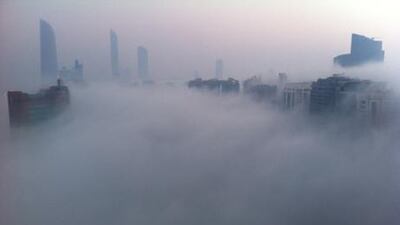DUBAI // Dubai's airport fell victim to the dense fog that swept back into the UAE with a vengeance this morning.
Dubai International Airport had a total of 21 flight diversions, three flight cancellations and a number of arrival and departure delays this morning as the thick mist caused problems.
A Dubai Airports statement said: "Weather conditions are expected to improve by 11am. Dubai Airports continues to work closely with airlines, air traffic control and control authorities to minimise disruption and customer inconvenience."
One traveller Peter Terence Ford tweeted: "Stuck at Dubai airport due to fog. Four hours of duty free shopping."
Another on twitter @CharlottDevaney shared: "Dubai airport mayhem right now. Missed my connecting flight along with the rest of the airport, oh the glamour."
Once again drivers across the emirates had to slow down in near zero visibility.
As the fog hung as low as the temperatures responsible for it, just 12C in Abu Dhabi, motorists were again urged to slow down, use fog lights and low-beams and avoid hazard lights and high-beams.
Again, the Dubai Road Transport Authority tweeted this morning: "Keep distance between the car in front of you and turn on your fog lights."
"Be quiet and patient and don't attempt to overtake or change your lane."
Drivers were on the receiving end of rare praise yesterday after a virtually accident-free day despite the thickest fog in years.
In the past fog has led to pile-ups, injuries and deaths on the roads, but only one four-car accident was reported in Dubai and none in Abu Dhabi.
“We have had no accidents today and want to thank the drivers for paying attention on the roads,” said Brig Hussein Ahmed Al Harithi, head of the traffic department at Abu Dhabi Police.
Maj Gen Mohammed Saif Al Zaffin, head of Dubai Police traffic department, said: “We have to praise drivers as only a few minor accidents occurred in the foggy conditions.”
The heavy mist descended on all major motorways as early as 3.30am and reduced visibility to near-zero. Police in Abu Dhabi and Dubai issued alerts urging drivers to use extra caution and drive safely.
The fog was caused by high pressure and calm conditions, which drove up relative humidity to about 100 per cent. More is expected for the next two days.
As the fog descended yesterday drivers used social media to warn of the adverse conditions, with “Holy morning fog! Can’t even see the building next to me!” while “Today was the worst fog I have ever witnessed … scary drive.”
Others criticised some people’s dangerous driving. Ahmad A tweeted: “I know it’s a foggy day today, that doesn’t mean u drive on the fast lane and take pics of the fog.”
The dangerous road conditions sparked police in Abu Dhabi into action, with an increase in patrols and, through radio and social media, instructions on how to drive in foggy conditions.
In Dubai, Maj Gen Al Zaffin advised drivers to make sure their car lights were in working order, drive slower than normal, keep a larger distance than normal between cars and, if the conditions were very bad, use hazard lights.
“Although some people say this indicates the car is stopped, the most important thing is to slow people down in these dangerous conditions and hazard lights do just that,” he said.
However, his instructions were contradicted by other organisations, including the Emirates Traffic Safety Society in Abu Dhabi.
“Using hazards in these conditions can deceive,” warned Brigadier Hasan Al Housani, its secretary general.
“When someone has their hazards on, you do not know whether they are about to turn left or right and are unsure of what is going on ahead.”
Dino Kalivas, the operation director at Emirates Driving Company, which teaches a course on how to drive in critical situations, said hazard lights should never be used in fog.
“We tell our drivers these lights should only be used for emergency cases,” he said. “Using them in any other instances sends a mixed message and it then becomes difficult to differentiate between emergency and non-emergency situations.”
Mr Kalivas said driving in fog affects the driver’s ability to anticipate risk; gives them a misconception of speed and distance; causes headlamps and road reflectors to be less effective; and decreases motorists’ peripheral vision, as they are fixated on the road ahead.
First and foremost, he advises to plan ahead and try to avoid driving late at night or early in the morning, when conditions are at their worst.
If you must drive in fog, preparation is key to decreasing risk, he said. Before even beginning the drive, motorists should have clean windows and mirrors, as dust decreases the already poor visibility; functioning windscreen wipers; and tyres in good condition and at the right pressure.
And once the drive has begun, there must be no distractions, such as mobile phones, as attention must focus on the road.
For the latest UAE weather forecast go to thenational.ae/weather


